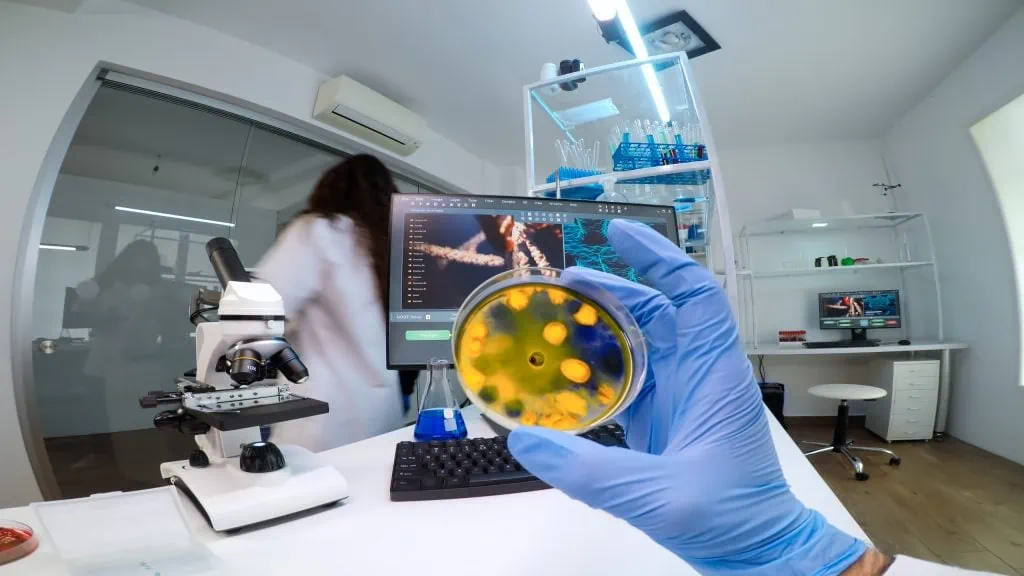There’s a huge controversy surrounding colloidal silver. As you get buried in search engine results touting its benefits or shouting the dangers you are exposing yourself to by taking this supplement, you can remain very confused (to say the least) regarding the efficacy and purpose of colloidal silver.
What is colloidal silver?
Firstly, a colloid (any colloid, not just colloidal silver) is defined as a substance that is microscopically dispersed in another substance (Wikipedia). As a result, colloidal silver is a liquid with microscopic silver particles suspended in it.
Colloidal silver has the ability to kill one-celled viruses, bacteria, and fungi by destroying the enzymes that support the metabolism and respiration of these cells, making the cells’ membrane more permeable, which also allows it to oxidize these cells, resulting in their death.
How does colloidal silver affect friendly bacteria?
Since colloidal silver has grown so popular mainly because it is an alternative to antibiotics, you might ask yourself: Does colloidal silver kill friendly bacteria like the one forming our gut flora or skin flora? Of course, it does. There is no way colloidal silver can tell apart friendly microbes from infectious ones.

However, taking small amounts of colloidal silver (up to an ounce daily), even in long term, is not enough to eradicate your gut flora. This is true mainly because that amount will only kill a small part of the gut flora (known for its ability to repopulate quickly).
Suppose you take more than an ounce a day, like when fighting a cold or another infection you should consider eating some probiotic foods or taking probiotic supplements during the treatment and a few days after. But why should you take colloidal silver instead of the traditional antibiotics if it also destroys the friendly bacteria inhabiting our digestive tract? Besides its potential effectiveness, unlike antibiotics, colloidal silver doesn’t cause resistant bacteria.
The increasing number of antibiotic-resistant bacteria, which are extremely difficult to treat and often not treatable at all, should make you think twice whenever you may require taking a course of antibiotics.
Is colloidal silver effective?
Depends on what you want to use it for. As a dietary supplement, it’s practically useless. The human organism does not need silver to sustain its functioning. There is no such thing as “silver deficiency” at least, there is no research that has revealed anything to support this.
Nevertheless, several doctors, such as Dr. Robert O. Becker in his book The Body Electric states he found a link between low silver levels and illness. Other doctors like cancer research scientist Dr. Gary Smith and the Swedish Dr. Bjorn Nordstrom, have successfully used silver to treat cancer patients. Obviously, this is worth looking into, and hopefully, the matter will benefit from more thorough research in the near future.
Usually, colloidal silver is used as a natural antibiotic and disinfectant both externally and internally. Recent studies have proven that colloidal silver can even kill certain types of antibiotic-resistant bacteria such as MRSA and tetracycline-resistant E. coli by itself or paired with antibiotics to boost their effectiveness. One of the researchers’ theories on the synergy between silver and antibiotics is that silver increases the permeability of the bacteria cell membrane (specifically gram-negative bacteria), which is otherwise impossible for antibiotics to penetrate because of their molecular size.

Does colloidal silver accumulate in the body?
Our bodies don’t deal too well with expelling metals we don’t need to support our metabolism (silver included). When taken in high amounts, silver – even in its colloidal form – can lead to argyria, the disease that can make you permanently look like a Smurf (blue or greyish-blue skin).
The most prominent case of argyria is Paul Karason, also known as the “blue man” and “Papa Smurf”. This man ingested 10-20 ounces of colloidal silver every day for 10 years before developing argyria. Also, he was making his colloidal silver using a DYI device. While the concentrations of his CS were never measured, according to Steve Barwick – a reputable health journalist from thesilveredge.com, author of several books on the matter – it was most likely a high concentration solution of “50 to 100 ppm or higher”.
So Paul Karason took unimaginable amounts of colloidal silver for a decade before turning blue. When taken in low to moderate amounts, a high-quality colloidal silver will NOT lead to argyria. On that note, too much of anything is bad for you, including water, especially after we’ve already seen that death by water is possible.
On the same website, you can find a dedicated page where the author has compiled numerous studies on colloidal silver, including the Altman study, which demonstrates that our bodies are capable and do excrete colloidal silver (mostly in urine). Obviously, this capacity to expel the silver is limited, so excess of silver in ANY form definitely leads to argyria.
How much colloidal silver is safe to take?
The Silver Safety Council has issued guidelines for calculating CS intake based on 3 perspectives: daily use, short-term use and entire lifetime. As long as you know you weight and the concentration of the colloidal silver (ppm-parts per million) you are taking, you can easily calculate the amount you can safely take.

How to find true colloidal silver products
Perhaps the biggest problem with colloidal silver is that it’s not easy to find it in its true form. The most prevalent product you can find is ionic silver (but the label could still say “colloidal silver”). Ionic silver is a solution of water and silver ions, not silver particles as is CS.
Marketplaces such as Amazon have a huge selection of colloidal silver products to choose from. However, it’s worth doing a bit of research into each brand/product to check the actual values of CS.
It’s true; ionic silver does contain some silver particles, just like colloidal silver contains some silver ions. However, ionic silver has very few silver colloids, so it’s not as effective as CS for internal use. If you respect the recommended dosage, ionic silver will not cause argyria. For external use, ionic silver is a powerful disinfectant.
You can use ionic silver both externally and internally, although for the latter, it doesn’t work as well as CS. How can you tell the difference between CS and ionic silver? First of all, ionic silver is a transparent liquid. Ionic silver has to be stored in glass containers because it interacts with plastic containers making the solution deteriorate in time. Also, it is photosensitive and needs to be shielded from light. Most likely, if it’s in an amber glass bottle, it’s ionic silver, not colloidal.
You can also test the presence of silver ions in the solution you’ve bought by adding table salt to it. Chloride ions interact with silver ions, forming a cloudy appearance. If this happens, then you have ionic silver.
Another type of product also sold under the name of “colloidal silver” is silver protein, which can actually pose a threat to your health in more than one way. Some manufacturers add protein (such as casein and Knox gelatin) to prevent the silver particles from settling. A high-quality CS does not need such additives because the silver particles do not settle.
Although silver protein products boast their high silver concentration (ranging from 30 to 2,000 ppm according to Dr. Mercola in this article), they are the least safe form of silver you could ingest. Silver protein is not effectively absorbed by the body, and using such products CAN lead to argyria. A simple test to find out if a supposed CS product contains silver protein is to shake the container. If it creates a persistent foam it means there is silver protein in it.
Sadly, true silver colloids are the hardest to find. These solutions contain mostly silver particles (50%-80%) and lower amounts of silver ions. Because silver particles don’t allow light to pass through, true colloidal silver will appear darker when held against the light. Also, colloidal silver is photo-stable and doesn’t need to be stored in amber or other dark-colored containers.
If you want to buy high-quality colloidal silver, you need to pay attention and do your research. Using lower quality products can at least be ineffective if not even damage your health. The easiest way to find the right product is to ask the advice of an alternative health practitioner. As long as you use a quality product and follow the guidelines (and common sense) colloidal silver can help in various ailments, safer but just as well as traditional antibiotics.
